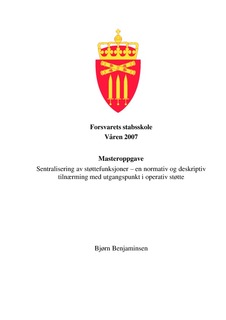| dc.description.abstract | This thesis discusses the delineation between Combat Service Support integral to the military arms and the parent trades in centralized support services. In recent restructuring processes within the Norwegian Armed Forces, this delineation has been challenged, and support functions formerly integrated with the military arms have been transferred to centralized support services. The reason for these changes has been a need for a more effective military organization in order to manage the economic and security challenges of tomorrow. In this quest, centralization and grouping by function has been promoted as the favored solution, and logistics- and support functions as the main areas to apply that solution. Using the foundations of New Public Management and the theories of Henry Mintzberg (1983) and Tom Colbjørnsen (1995) I have presented a normative model for the structuring of the Armed Forces, with emphasis on grouping. In this model, the military arms are structured as market oriented units containing all necessary services specific and essential to their mission and environment. Centralized services are grouped by function to exploit economies of scale and trade. Transferring capacities from the military arms requires that these capacities are not specific to the military arm in question, and that substantial economies of scale or benefits by synergy must be established, while the operational needs of the military arm are met. Six criteria have been formed on the basis of the presented model to evaluate my findings in the descriptive part of the thesis. In the descriptive part, I have studied the medical and CBRN capacities of the Navy and the Air Force to evaluate their current state. The study has been based on interviews and other sources. The findings revealed significant differences between the two military arms. While the Navy seemed to have managed to maintain a fairly complete organization, the Air Force had accepted the ”rules of the game” and adjusted to a reality where many aspects of its activities are dependent on support from centralized functions. My conclusion is that the restructuring of the Armed Forces might be founded on relevant theories, but not in a uniform and expressed manner. Regarding the Air Force, the restructuring had led to shortfalls within the areas of Role 1 medical support and CBRN compared to requirements. The shortfalls are identified, and efforts are being made to rectify the situation. | en_US |
